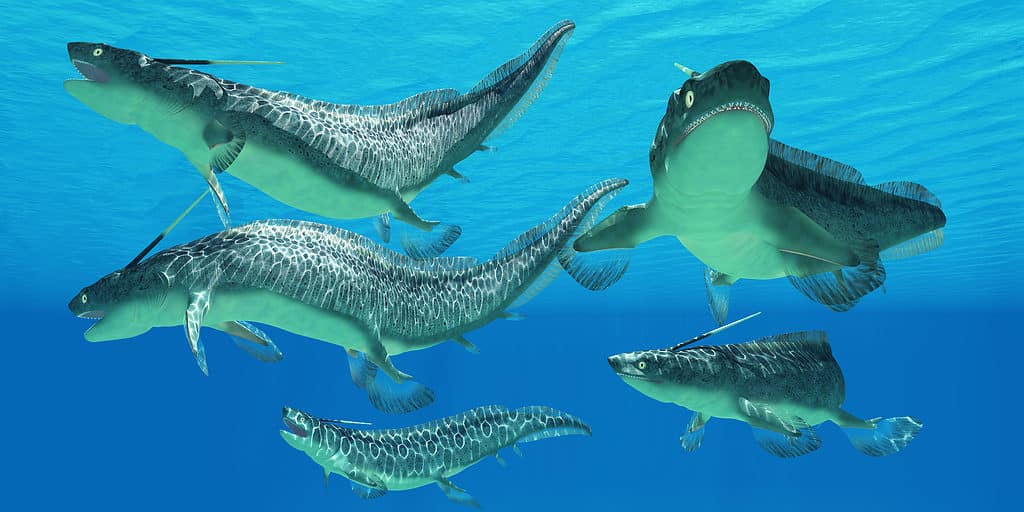Xenacanthus
The Xenocanthus had a large venomous spine behind its head!
Advertisement
Xenacanthus Scientific Classification
- Kingdom
- Animalia
Read our Complete Guide to Classification of Animals.
Xenacanthus Conservation Status
Xenacanthus Facts
- Prey
- Crustaceans small fish
- Fun Fact
- The Xenocanthus had a large venomous spine behind its head!
- Most Distinctive Feature
- Large spine near dorsal fine
View all of the Xenacanthus images!
The Xenacanthus was a small freshwater shark that went extinct around 200 million years ago.
They are a prehistoric genus of sharks. It went extinct at the end of the Triassic period, about 202 million years ago. They were widely distributed and lived from the Devonian to the end of the Triassic period. The name Xenacanthus is a Greek word that means “foreign spine”. Very few complete fossils have been found. Most information about the animal has been found through teeth and spine samples. The Xenacanthus was a freshwater shark.
Scientific Name
Xenacanthus comes from the greek words xénos, meaning foreign “foreign” or “alien” and akanthos, meaning “spine”. Their fossils or small samples were found in freshwaters all over the world. These fish appeared in the Devonian period, “the Age of the Fish”. During this period, the jaws of fish evolved and developed. Scientists believe they eventually evolved to become amphibians that could live in semi-aquatic environments.
Description & Size

Very few complete fossils have been found, and most information about the animal has been found through teeth and spine samples.
©iStock.com/CoreyFord
The features of Xenacanthus were very distinct compared to today’s sharks. They were about 3 to 5 feet long, with a maximum length of 6 feet. So, about the same length as a 10-year-old child.
They had a long dorsal fin that extended down their backs and tails before merging with the anal fin. So they looked more like modern-day eels than sharks. They also are believed to have a similar swimming style to conger eels. In addition, the Xenacanthus had a sizeable dorsal spine that extended from behind its head. The spine extended outwards and could at times be as long as 1-foot long, giving it its name xénos, meaning “foreign” or “alien” and akanthos, meaning “spine”.
Unlike most fish and sharks that have cartilage in their backs, the spine was formed from bone. This spine grew with annulated rings around it, which scientists have used to calculate the animal’s age. The spines of the female Xenacanthus were longer than the males, and it is believed the spines contained venom, which the Xenacanthus would use to defend itself. They had unique “V-shaped” teeth, allowing them to feed on small crustaceans and other fish.
Overall, they had slim, elongated bodies with fins on the underside. They did not have the common shark morphology. Instead, their bodies were similar to the stingrays and eels today.
Diet – What Did The Xenacanthus Eat?
The Xenacanthus was a carnivorous genus of freshwater sharks that fed on smaller fish and crustaceans. These predictions of their diet were made by scientists because of their “V-shaped teeth” that have double-pointed edges, which are perfect for eating small crustaceans.
Nevertheless, this creature went extinct a VERY long time before humans existed, so these conclusions about “what did the Xenacanthus eat?” are primarily based on their habitat and teeth structure.
What Ate The Xenacanthus?
The Xenacanthus was a small predatory creature, so it is very probable that it was preyed on by larger aquatic and semi-aquatic animals. For example, the Rutiodon was a massive crocodile-like predator that lived at the same time as the Xenacanthus and therefore was a possible predator. The large venomous spine on the Xenocanthus’s head would have proved a useful weapon to defend itself.
Habitat – When And Where It Lived
The Xenacanthus lived in freshwater bodies such as rivers, lakes, and streams. Based on the isotope analysis of their teeth, scientists predict that they didn’t migrate from their habitats very often. They have been found in areas worldwide, such as the US, India, Europe, and Australia. Like eels and stingrays, they are believed to have spent most of their time at the bottom of bodies of water, feeding on crustaceans and small creatures.
Threats And Predators
The Xenacanthus was an apex predator in freshwater bodies, meaning they were at the top of the food chain. They were sometimes preyed on by Dimetrodon, a synapsid that lived in the Permian era, and the Rutiodon, a crocodile-like predator that lived during the Triassic period.
Other possible threats that affected the population of the Xenacanthus were the changes to the climates and weather that occurred during the Triassic period. As a result, the freshwater environment changed, which could be attributed to their decrease and eventual extinction.
Discoveries and Fossils – Where It Was Found
Not many fossil specimens have been found for the Xenacanthus, and most of the fossils have been spine remains and teeth. The first fossil of the Xenacanthus was discovered in Germany by paleontologist Heinrich Ernst Beyrich in 1848, mainly consisting of teeth and vertebrae. The venomous spine was the most distinct feature of the Xenacanthus, which gave the genus its name.
There were over 21 species of this genus that lived all over the world, and fossils were found in distinct areas. It must be noted, however, that all the different species of Xenocanthus did not live during the same time period. The different species lived at different periods during the time that the genus existed.
Overall, 39 collections of fossil specimens were found in the following locations:
- India
- United States (New Mexico, Texas, Oklahoma, Utah)
- Australia
Extinction – When Did It Die Out?
The Xenacanthus was one of the few genera that survived the mass extinction event of the Permian period that wiped out 70% of the world’s population and 96% of all marine life. However, at the end of the Triassic period, another mass extinction event occurred on Earth. The leading cause of that Triassic extinction event is still unknown. It could be anything from volcanic eruptions, dramatic climate change, an asteroid falling to the earth, or a combination of these factors. Unfortunately, the resilient genus of Xenacanthus could not survive this event and went extinct along with the majority of other species.
The specific reason why this genus went extinct during the mass extinction event is still unknown, although it is likely that the population of their prey declined, causing them to eventually die out as well.
Similar Animals To the Xenacanthus
Other animals that were similar to the Xenacanthus genus of sharks were as follows:
- Conger eels – A currently living species of eels, their dorsal fins have a ribbon-like texture and shape that extend from the head all the way to their backs. The Xenacanthus swam in the water in a similar manner to them.
- Hybodus – Another early type of shark, the Hybodus had extended spikes like the Xenacanthus, which rose up from the dorsal fin, much like the outward spines of the Xenacanthus.
- Australian lungfish – The Australian lungfish resembles the Xenacanthus in that they have similar pectoral fins, with a segmented middle axis, much like a leaf. The Australian lungfish is the only living species with pectoral fins like the Xenacanthus.
- Orthacanthus – Another extinct freshwater shark, the Orthacanthus could’ve been a possible competitor to the Xenacanthus. They also had long spines extending all the way down their body. Hence, they also belong to the same family as the Xenacanthus, Xenacanthida. The fossils of these species were also used to help reconstruct the possible structure of a Xenacanthus body.
Related Animals
View all 13 animals that start with XXenacanthus FAQs (Frequently Asked Questions)
When was the Xenacanthus alive?
The Xenacanthus lived from the Devonian to the end of the Triassic period, about 202 million years ago.
How big was the Xenacanthus?
The Xenacanthus were about 3-4 feet long, with the longest fossil specimen being 6 feet long.
What were the predators of the Xenacanthus?
The Xenacanthus was an apex predator in most freshwater bodies. However, it was a small creature that was likely preyed on by larger animals such as the Dimetrodon and the Rutiodon.
Was the Xenacanthus a carnivore, herbivore, or omnivore?
Xenacanthus was a carnivorous creature that fed on small fish and crustaceans in freshwater bodies like rivers.
Thank you for reading! Have some feedback for us? Contact the AZ Animals editorial team.
Sources
- , Available here: https://en.wikipedia.org/wiki/Xenacanthus">https://en.wikipedia.org/wiki/Xenacanthus
- , Available here: https://australian.museum/learn/animals/fishes/xenacanthus/">https://australian.museum/learn/animals/fishes/xenacanthus/
- , Available here: https://www.britannica.com/animal/Xenacanthus">https://www.britannica.com/animal/Xenacanthus
- , Available here: http://www.prehistoric-wildlife.com/species/x/xenacanthus.html
- , Available here: https://fossil.fandom.com/wiki/Xenacanthus
- , Available here: https://dinopedia.fandom.com/wiki/Xenacanthus
- , Available here: https://chondrichthyes.fandom.com/wiki/Xenacanthus
- , Available here: http://www.fossilworks.org/cgi-bin/bridge.pl?a=taxonInfo&taxon_no=80813#

















